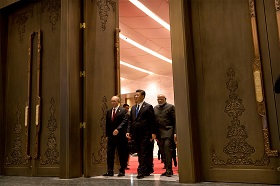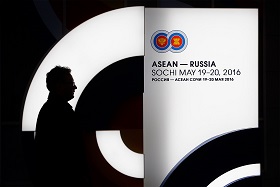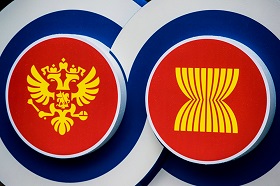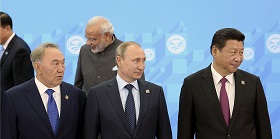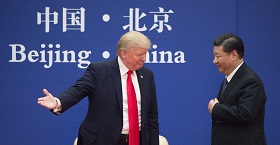When Russian Foreign Minister Sergey Lavrov attended the ASEAN Foreign Ministers’ Meeting in August 2018 it was revealed that President Vladimir Putin was planning to take part in the upcoming East Asia Summit (EAS) in Singapore this November. This will mark the first time that the Russian leader has attended the event since the country became full member of the EAS. Putin will also pay a state visit to Singapore and take part in the Fourth ASEAN–Russia Summit.
The President’s participation in the EAS has been a long time coming and his attendance will demonstrate that Russia is taking multilateral diplomacy in Asia seriously and that it cares about the EAS as the main ASEAN-centred security mechanism. Does Vladimir Putin’s upcoming trip to Singapore indicate that Russia is pushing a new agenda in its Asian policy?
The problems of ASEAN-centred mechanisms are not unique to multilateral diplomacy and, of course, do not diminish the significance of the EAS for Russia. First of all, Vladimir Putin’s participation in the East Asia Summit is not as important for the EAS as such as it is for Russia–ASEAN relations. The East Asia Summit is important as a vanity project for ASEAN, a living embodiment of the principle of ASEAN centrality, when all the great powers in the Asia-Pacific Region come together under ASEAN convening power to discuss regional issues. The declaration following the Third ASEAN–Russia Summit in Sochi noted, in typical ASEAN-speak, that more attention on the part of Russia towards the EAS would serve as an important step on the way to upgrading the status of the dialogue partnership between Russia and the ASEAN to ‘strategic dialogue.’
In this sense, the President’s trip to Singapore in November can only be a success. Russia will remind everyone of its status as a major player in the region and share a vision of the regional security system that will be difficult not to support. President Putin will talk about the Greater Eurasian Partnership – Russia’s idea of a vast space with unified rules of the game in trade an investment, stretching all the way from the European Union to ASEAN. Commentators will point to Russia’s significant potential to play the role of a third force, whose appeal will only grow as the competition between China and the United States intensifies.
The ‘third force’ idea has long existed in the Russian discourse on Asian politics but requires critical assessment. There are two key weaknesses in the argument. First, Russia does not enjoy a high level of influence in Southeast Asia, and its objective ability to bring attractive proposals to the region is also limited. Second, there are growing doubts in the region about Russia’s autonomy in Asian affairs.
For Russia, which does not have the resources of China or the US, a sensible long-term strategy would be to strengthen the institutional framework, especially if it works at the same time to increase trust in Russia as a country that adheres to the rules of international cooperation.
When Russian Foreign Minister Sergey Lavrov attended the ASEAN Foreign Ministers’ Meeting in August 2018 it was revealed that President Vladimir Putin was planning to take part in the upcoming East Asia Summit (EAS) in Singapore this November. This will mark the first time that the Russian leader has attended the event since the country became full member of the EAS. Putin will also pay a state visit to Singapore and take part in the Fourth ASEAN–Russia Summit [1].
The President’s participation in the EAS has been a long time coming and his attendance will demonstrate that Russia is taking multilateral diplomacy in Asia seriously and that it cares about the EAS as the main ASEAN-centred security mechanism. Does Vladimir Putin’s upcoming trip to Singapore indicate that Russia is pushing a new agenda in its Asian policy?
A List at the End of a List
Just like there seems to be no country whose geographic position is not strategically advantageous, it would seem that there is no area of Russia’s foreign policy that is not a priority of some sort. In the official discourse, it is not customary to talk about Russia’s own pivot to the East, because formally there was no change in the priorities and East Asia has always been one. But speaking realistically, it can also be said the priories remain unchanged in the sense that Asia is still a secondary focus for Russia’s foreign policy efforts compared to other areas that are of priority concern mostly because they are prone with conflict.
At the same time, while Russia and the West seem unable to resolve their protracted conflict, Asia remains an important source of good news for Russia, an area where constructive forms of international relations still prevail over various forms of geopolitical competition. The Eastern Economic Forum held in Vladivostok in early September, which was attended by the heads of state or government of China, Japan, South Korea and Mongolia, is a good example of such positivity.
Perhaps it is image of relative harmony that makes the topic of Asian multilateral institutions less interesting for observers and relegates it to the bottom of the list of the priority areas of Russian policy in Asia. When Russian official speak of the country’s Asia policy, they usually start with Russia’s bilateral relations with regional leaders – China, Japan, South Korea and India – before turning to the Korean nuclear problem. Only then do they list the various multilateral diplomacy institutions around the Association of Southeast Asian Nations (ASEAN): the ASEAN–Russia Dialogue Partnership; the ASEAN Defence Ministers’ Meeting with Dialogue Partners (ADMM-Plus); the East Asia Summit; the ASEAN Regional Forum (ARF); and Conference on Interaction and Confidence-Building Measures in Asia (CICA), among others.
Meanwhile, multilateral diplomacy in Asia is an agenda item that checks several crucial boxes for Russian foreign policy ideology.
First, the region is home to rising powers which, according to the official Russian theory, will build the new ‘polycentric world’ and these players include both individual countries such as China, India or Indonesia and organizations like the SCO and ASEAN itself. Second, the principle of non-alignment, multilateralism and inclusivity in the form of ASEAN-centric organizations is still in vogue here, that is, there is ‘Asian NATO’, but instead a dense network of inclusive dialogue platforms (even North Korea takes part in ARF meetings). Third, ASEAN and larger formats around it continue to take the principle of non-interference in the domestic affairs of states very seriously and avoid discussing each other’s domestic workings, which is also in the set of values that Russia is promoting on the international arena.
At the same time, all of this ideological affinity is not easily converted into practical cooperation. Every year, dozens of events are held within the framework of the ADMM, ADMM-Plus, ARF and EAS platforms, which are attended by the ASEAN dialogue partners. Diplomats from the partner countries are well aware of how difficult it is to maintain meaningful participation in all of them. It was only last year the Russia – last of the dialog partners – opened a full representation to ASEAN and given the limited international competencies of most Russian ministries, the Ministry of Foreign Affairs and the relevant subdivisions of the Ministry of Economic Development remain disproportionately burdened with maintaining Russia’s participation in these formats.
In practical terms, the most visible step taken by Russia in multilateral institutions in Asia was the 2010 initiative to launch a “dialogue on issues of forming a new security and cooperation architecture in the region” within the EAS format. The set of characteristics that make up this system changes from speech to speech, but is usually said to be based on principles of collectiveness, multilateralism, equality, inclusiveness, openness, non-alignment and indivisibility. In the real world, Russia’s initiative is embodied in a series of working-level workshops on the regional security architecture. Six such workshops have been held and are usually attended at the level of division chiefs. There are also plans for a format where EAS ambassadors in Jakarta are to discuss the topic.
An initiative of this kind clearly appeals to ASEAN as an organization in the very centre of multilateral diplomacy in Asia, all the more so because the selection of principles proposed by Russia is recognized, at least vocally, by almost every single member of the United Nations. But even this seemingly win-win ideological construct runs into harsh geopolitical realities. In private conversations, ASEAN diplomats have in recent years expressed scepticism about Russia’s ideological leadership in this initiative: they say that it is not Russia’s place to talk about the indivisibility of security and then conduct joint military exercises with China, which the smaller countries in Southeast Asia evidently fear.
However, the main difficulty for the Russian initiative is different – as with many other processes in ASEAN-centric formats, it is not entirely clear whether an initiative on the creation of a new security architecture will come to life beyond workshops and statements. There is reportedly a collective document that could, following discussions, form the basis for a set of rules of conduct in the Asia-Pacific Region that could then be converted into another document that may even turn out to be legally binding.
Russia’s participation in ASEAN-centred multilateral mechanisms is not limited to the initiative. For example, Russia along with Laos is co-chair of the ADMM-Plus Expert Working Group on Humanitarian Mine Action. In 2014–2017, it co-headed (with Thailand) a similar group on military medicine. In 2019–2020, Russia will, alongside Indonesia, co-chair the ARF Inter-Sessional Meeting on Counter Terrorism and Trans National Crime.
The (Not) New Sheriff In Town
Multilateral diplomacy in East Asia has traditionally enjoyed the support of all the key players in the region. However, this is mainly due to its openness and inclusivity. Unfortunately, this inclusivity proceeds from avoiding any kind of hard position or going against the consensus. Serious security issues are discussed on these multilateral Asian platforms that first seek to not offend anyone be uncontroversial and only then to be effective or even meaningful. What is more, the major powers support the ASEAN centrality because they know that ASEAN is in no condition to enforce any decision. This means that the United States and China can act pretty much as they please without feeling any kind of restrictions on the part of the regional community.
None of this means, however, that the numerous dialogue mechanisms that exist in the Asia-Pacific region are purely imitative and decorative in nature. They perform an important function – namely, socialization and the creation of an information flow among states. This mutual awareness of each other’s intentions, interests and positions should in theory build trust among all players or at least remind them that when crisis strikes there is a platform where they can talk before taking up arms. In other words, the multilateral security system in Asia works, although it does not meet the grand expectations of observers who want to see it as a safeguard of international security in Asia. On the other hand, recent experience of Europe demonstrates that we relying too much on collective security systems.
When faced with any serious security challenge, the countries in the Asia Pacific rarely rely on multilateral institutions for protection or mediation. And the fact that they turn to more traditional foreign policy instruments underscores the inability of multilateral mechanisms to fulfil their stated functions. The new concepts and strategies that have emerged in Asia and are designed to counterbalance China will be seen by many smaller countries in the region as an opportunity to gain real protection from Chinese assertiveness, at least to the extent possible.
In the coming years, these alternative formats will likely revolve around all sorts of ‘Indo-Pacific’ initiatives and platforms. The revived U.S.–Japan–Australia–India quadrilateral dialogue - no doubt aimed at new and better containment of China - will also extend its cooperation formats to a wider audience of partners in Asia. The key partners here will most likely be Indonesia, Singapore and Vietnam.
Another example is America’s Indo-Pacific Economic Vision announced recently as the economic leg of the ‘free and open Indo-Pacific’ strategy. The long-awaited trilateral partnership for Indo-Pacific infrastructure investment has also arrived. While these initiatives do not seem to be as ambitious as China’s Belt and Road Initiative, they do already have an advantage over it - they are not Chinese. In today’s climate of growing fears of debt trapping and Chinese ‘sharp power’ this gives a measure of hope to U.S. and Japanese infrastructural investors aiming at Southeast Asian and Eurasian markets.
All this creates challenges for the relevance of multilateral institutions in Asia. When the Quad re-emerged November 2017, the news caused concern in Southeast Asian countries: what will this mean for ASEAN centrality? This concern was addressed by a diplomatic appeasement campaign, as Deputy Assistant Secretary of State Alex Wong went on an extensive tour of Asia to calm the waters. An important result of this work was the joint statements made by the Quad foreign ministries following the second meeting on June 7, 2018, with all four texts essentially boiling down to a reaffirmation of ASEAN centrality.
Even without these new plurilateral formats, ASEAN-centred mechanisms were a target for criticism. For example, every time the situation on the South China Sea flares up, ASEAN is criticized for not being able to adopt a unified position. The ten member states of ASEAN are to varying degrees willing – or, rather, unwilling – to upset China. This is why they prefer to adopt a position with the lowest common denominator. ASEAN and China have been developing a Code of Conduct for the parties in the South China Sea for several years now. The document should be an important milestone in the settlement of the conflict, or at the very least reduce tensions in the region. A Single Draft was only agreed upon this year, and it is nothing more than a set of asks from all parties – even the most glaring contradictions have not been removed.
What Russia Brings to the Table
The problems of ASEAN-centred mechanisms are not unique to multilateral diplomacy and, of course, do not diminish the significance of the EAS for Russia. First of all, Vladimir Putin’s participation in the East Asia Summit is not as important for the EAS as such as it is for Russia–ASEAN relations. The East Asia Summit is important as a vanity project for ASEAN, a living embodiment of the principle of ASEAN centrality, when all the great powers in the Asia-Pacific Region come together under ASEAN convening power to discuss regional issues. The declaration following the Third ASEAN–Russia Summit in Sochi noted, in typical ASEAN-speak, that more attention on the part of Russia towards the EAS would serve as an important step on the way to upgrading the status of the dialogue partnership between Russia and the ASEAN to ‘strategic dialogue.’
In this sense, the President’s trip to Singapore in November can only be a success. Russia will remind everyone of its status as a major player in the region and share a vision of the regional security system that will be difficult not to support. President Putin will talk about the Greater Eurasian Partnership – Russia’s idea of a vast space with unified rules of the game in trade an investment, stretching all the way from the European Union to ASEAN. Commentators will point to Russia’s significant potential to play the role of a third force, whose appeal will only grow as the competition between China and the United States intensifies.
The ‘third force’ idea has long existed in the Russian discourse on Asian politics but requires critical assessment. There are two key weaknesses in the argument.
First, Russia does not enjoy a high level of influence in Southeast Asia, and its objective ability to bring attractive proposals to the region is also limited. While the countries in the Indo-Pacific currently account for a third of Russia’s foreign trade, for none of these countries does Russia itself exceed 3 per cent. Russia has unique products and services in several strategically important sectors – arms trade, information security, minerals and energy. However, this proposal has existed for several decades now, while the results (with the exception of Vietnam) have been spotty. The same goes for the Russian military presence in the Western Pacific; this presence is reasonably limited, which, on the one hand, reduces the risk of Russia being drawn into regional conflicts. On the other hand, it prevents Russia from playing in the same league as the United States and China.
Second, there are growing doubts in the region about Russia’s autonomy in Asian affairs. Thanks to the coverage by international media and experts, Russia is increasingly seen as a country whose deteriorating relations with the United States are making it more and more dependent on China. The nuances of Russia’s balanced stance on the South China Sea, for example, are no longer seen as such behind the smokescreen of joint military exercises with China and the support of Beijing’s refusal to recognize the decision of the Permanent Court of Arbitration in The Hague in 2016.
In this context, Russia may find it difficult to portray itself as a third force in Asia. It may be more worthwhile to invest more in maintaining the existing mechanisms of multilateral diplomacy. For Russia, which does not have the resources of China or the US, a sensible long-term strategy would be to strengthen the institutional framework, especially if it works at the same time to increase trust in Russia as a country that adheres to the rules of international cooperation. Building practical cooperation and developing new initiatives in multilateral mechanisms in Asia to match its rhetoric could have a positive reputational effect for Russia and its influence in Southeast Asia at a relatively low cost, even if it is old-fashioned and naïve to talk earnestly about collective security these days.
Such a strategy would no doubt require more serious investments in the bureaucratic, intellectual and organizational support of Russia’s work in multilateral mechanisms in Asia. It is necessary to gain the understanding and support of all stakeholders throughout the executive branch in order for Russia to step up its participation in the dozens of issue-specific dialogues under the ASEAN banner.
1. At the time of publication, there is no official confirmation that the ASEAN–Russia Summit will take place; however, recent statements made by Deputy Minister of Economic Development of the Russian Federation Sergey Gorkov during his visit to Singapore imply that it will. See: http://economy.gov.ru/minec/about/structure/depasiapacific/201802091


